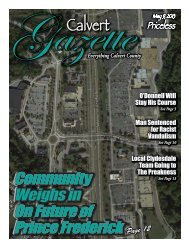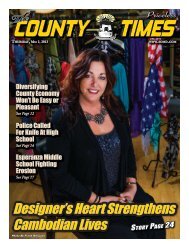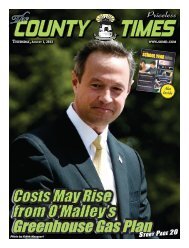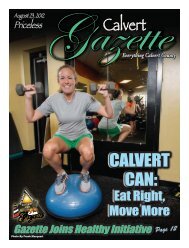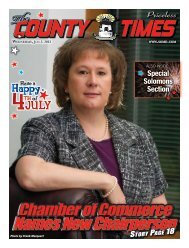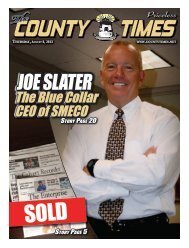christmas behind bars - County Times - Southern Maryland Online
christmas behind bars - County Times - Southern Maryland Online
christmas behind bars - County Times - Southern Maryland Online
Create successful ePaper yourself
Turn your PDF publications into a flip-book with our unique Google optimized e-Paper software.
11 Thursday, December 22, 2011<br />
The Calvert Gazette<br />
STORY<br />
Jail Chaplain to Meet<br />
By Corrin M. Howe<br />
Staff Writer<br />
With Each Inmate<br />
On Christmas<br />
Day, Chaplain Jerald<br />
Graham will<br />
stop by every cell<br />
in Calvert <strong>County</strong>’s<br />
Detention Center<br />
to give out Christmas<br />
cards and visit<br />
with each inmate.<br />
It is another way he<br />
and other volunteers<br />
serve a part of the<br />
population locked<br />
away from sight and<br />
memory.<br />
Although<br />
the time between<br />
Thanksgiving and<br />
the New Year is<br />
called a time for<br />
giving and spreading<br />
cheer, the average<br />
citizen, church<br />
group or service<br />
organization cannot<br />
serve the local prison population on the holidays.<br />
For the health and safety of everyone<br />
involved, Graham says there are very specific<br />
rules about what can be brought into the jails<br />
and all volunteers have to go through training<br />
first.<br />
Graham is part of a volunteer ministry<br />
called Point of Change Jail and Street Ministry,<br />
Inc. out of Waldorf founded by Chaplain<br />
John Lewis. In 2008, Charles <strong>County</strong> Detention<br />
Center welcomed Lewis as their Chaplain<br />
after he’d served as a volunteer there.<br />
Graham heads up the Calvert program<br />
Point of Change runs 17 “sessions” a<br />
week in Calvert’s Detention Center. The majority<br />
of the sessions are religious services,<br />
10 to be exact, and the others are educational<br />
in nature including a program called REST<br />
– Rehabilitation Empower Structure Transition.<br />
Residents on their way out of the center<br />
and back into the community can apply to<br />
enter into the program which teaches computer<br />
skills, anger management, goal setting,<br />
resume writing, interviewing skills, first aid<br />
and other programs<br />
Since the program started in Calvert<br />
none of the inmates have returned to jail,<br />
something Graham and Lewis are proud of,<br />
considering the national recidivism rate is<br />
43.3 percent of inmates return within three<br />
years of being released.<br />
Point of Change is volunteer driven and<br />
has a budget which comes strictly from donations.<br />
At this point it has brought in nearly<br />
$22,500 in annual revenue but has paid out<br />
over $26,000 in expenses.<br />
“We do the work and have faith” that the<br />
financial needs will be met, said Graham. He<br />
would love to see local churches willing to<br />
donate even $25 a month to the work to help<br />
them “keep their head above water.”<br />
Graham volunteers nearly full-time and<br />
works shift work at the Metro. His wife also<br />
has a full-time job which provided for his<br />
family.<br />
“Seeing lives changed for the better<br />
means more than any dollar amount,” he said,<br />
when asked how he can invest so much of his<br />
time administrating 75 services a month.<br />
A number of local churches support the<br />
jail ministry as well. They send volunteers to<br />
run Bible studies and educational programs.<br />
He said he has one volunteer who has been<br />
there 20 years.<br />
Anyone wanting to come in to volunteer<br />
has to go through a three to four hour class<br />
after a clearance check. After the class the<br />
volunteer will receive a badge. The training is<br />
“very important because the officers go over<br />
the dos and don’ts.”<br />
The reason for providing training sessions,<br />
especially at the local jails, is to help<br />
the inmates develop skills and make better<br />
choices when they return. Otherwise, “they<br />
return back to the same community which got<br />
them in trouble to begin with,” said Graham.<br />
Space is a limiting factor in the number<br />
of programs they can offer. He can only<br />
schedule 12 inmates at a time for a session<br />
of any kind, religious or educational. Each<br />
week he puts out a list and inmates sign up<br />
for something they want.<br />
Graham said if he could “write a check”<br />
he could purchase a facility in which he could<br />
help with at-risk youth and work with them<br />
before they make bad choices. At the same<br />
facility he would run follow up programs for<br />
those transitioning out of jail.<br />
He would also partner with more local<br />
churches to provide the “after care” necessary.<br />
It could be as simple as churches providing<br />
classroom space for his volunteers to<br />
continue teaching computer skills, job readiness,<br />
matching positive mentors up with at<br />
risk youth and helping them find productive<br />
channels for their energy and creativity.<br />
“All the youth we work with say they<br />
made the wrong choices. We teach them not<br />
to allow peer pressure to get them down the<br />
wrong path,” said Graham.<br />
The programs in the jail are even helping<br />
those not participating, according to Graham.<br />
“They see the lives changing and they want to<br />
be a part of that.”<br />
By Corrin M. Howe<br />
Staff Writer<br />
‘What Teaching In<br />
Prison Taught Me’<br />
Everybody has a story to tell. Merle<br />
Morrow, like many, experienced a life changing<br />
event on Sept. 11, 2001. She was a civil<br />
rights attorney working for the Department of<br />
Justice conducting an investigation at a men’s<br />
maximum security prison. As she was escorted<br />
to where she had to go, the guards walked<br />
her through a chapel where several inmates<br />
were preparing a service.<br />
“The men in here are as devoted to their<br />
country as people on the outside, but many<br />
can’t write an intelligent letter to us – their<br />
government – to ask for help,” she said. Then<br />
she asked herself what she was going to do<br />
about it.<br />
Long story short, she left her job on Sept.<br />
28, 2001. By April 2002, she had received orientation<br />
to become a GED teacher at <strong>Maryland</strong><br />
House of Correction, commonly referred<br />
to as the Cut. She spent three years at a maximum<br />
security men’s prison in a room full of<br />
men convicted of significant crimes. She was<br />
alone with them twice a week with the closest<br />
guard down the hall and around the corner.<br />
“It was a one room school with educational<br />
levels from 1st to 12th grade. I didn’t<br />
know enough to panic. I’d never taught before<br />
and had a room full of students. We had fun in<br />
the classroom. These men worked hard. They<br />
did their homework. They wanted to grow as<br />
human beings even though some knew they’d<br />
never get out,” said Morrow, who wrote about<br />
her experience in a book called “So Am I:<br />
What Teaching In Prison Taught Me.”<br />
The first thing she had to do was convince<br />
herself that these men “were fellow<br />
children of God” and worthy of respect. So<br />
she went in right away, ready to look them in<br />
the eye. The first year and a half she worked<br />
with her students, she didn’t know what kinds<br />
of crimes they committed. However, when<br />
they asked her to write a book about them, to<br />
show the world that they are just like everyone<br />
else only having made bad choices, Morrow<br />
realized she needed to learn about their<br />
crimes.<br />
Once she started reading the trial records,<br />
she went through a “spiritual struggle”.<br />
“How do I go back into the classroom?<br />
These men had become my friends. It is different<br />
having a friend as a rapist than it being<br />
a stranger,” she said.<br />
On the other side of her struggle, she realized<br />
“these men aren’t one thing or another.<br />
They were more than their horrible crimes.<br />
They wanted to be better people. They wanted<br />
to give back.”<br />
While she was working there, she had<br />
seen conditions which troubled her. She wanted<br />
to make a change, but didn’t know how.<br />
Then she had a spiritual director tell her, “You<br />
have to change hearts before you can change<br />
systems.”<br />
She hopes her book will change hearts.<br />
“Even if my book only changes two, it will<br />
be a start.”<br />
Her students asked her to write the book<br />
about their experiences. She agreed and decided<br />
to donate the proceeds to at risk programs<br />
for youth at the request of her students.<br />
She would love to come talk to groups<br />
and organizations who want to learn more<br />
about her experience and how they can help<br />
change one heart at a time by working with<br />
youth before they end up in prison or helping<br />
to educate those in prison so they don’t<br />
return.<br />
Contact her at: A Closer Connection,<br />
LLC, P.O. Box 70, Owings, MD 20736 or<br />
www.teachinginprison.com.<br />
Morrow agreed to write some of<br />
her students with questions from the<br />
Calvert Gazette. Here are some of their<br />
thoughts:<br />
How can society help prevent people<br />
from ending up in prison?<br />
“Society can start programs, open<br />
up jobs, schools. Teach people to learn<br />
to do the right things in life. Teach them<br />
about going to church, treat people with<br />
respect.” - James Hill.<br />
“Help youth to be interested in/<br />
like different types of trades and apprenticeships<br />
programs. Which provide<br />
a great education as well as a<br />
great means of living, having recover<br />
programs for adults, more affordable<br />
educational classes, more interactive<br />
self-help groups.” - Donti Hayes<br />
“Society needs to invest money<br />
in the kids; recreation and vocational<br />
training.” - Thomas Maddox.<br />
“I believe it starts with at risk kids.<br />
Because the at-risk kids that enter juvenile<br />
facilities, three out of four become<br />
adult offenders. So society must give<br />
them what they need while they are<br />
young.” James Wells.<br />
What kinds of programs are<br />
needed in prison? If you could control<br />
prison programming what would you<br />
provide?<br />
“Reinstitute an emphasis on rehabilitative<br />
programming. Since the<br />
majority of prisoners are destined to<br />
return to society it seems logical and<br />
practical to have them better prepared<br />
to return to society.”<br />
“More programs that will enhance<br />
a person’s educational level and<br />
programs that prepares men for employment<br />
and gives them life skills.”




